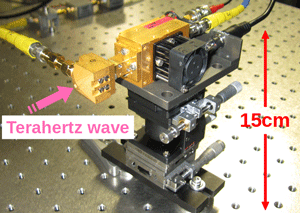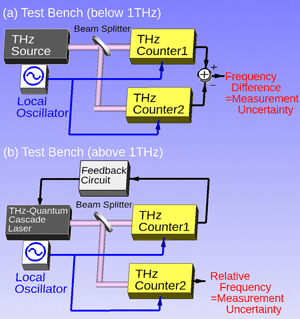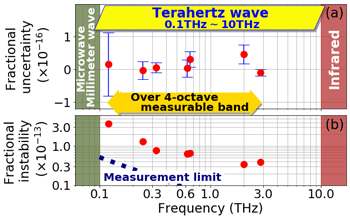Abstract
The National Institute of Information and Communications Technology (NICT, President: TOKUDA Hideyuki, Ph.D.) has developed a broadband and high-precision terahertz (THz) frequency counter based on a semiconductor-superlattice harmonic mixer. It showed a measurement uncertainty of less than 1 x 10-16 from 0.12 THz to 2.8 THz. This compact and easy-to-handle THz counter operating at room temperature suits for various THz applications supported by the next-generation ICT infrastructure, “Beyond 5G / 6G”.
This achievement was published in Metrologia as an open-access paper on July 19, 2021.
Achievements

Figure1 THz counter developed at NICT
A highly-accurate and wide-measurable band THz frequency counter will become a key metrological instrument for allocation of THz spectrum among huge range of users on the next-generation information and communications infrastructure, or Beyond 5G / 6G. It is also indispensable to high-resolution spectroscopy of ultracold molecules. NICT developed the counter by generating a THz frequency comb from a semiconductor-superlattice harmonic mixer, which is simple, easy to use and operational at room temperature. Consequently, more compact and easy-to-handle counter than previously reported ones requiring an ultrashort pulse laser or a bulky cryogenic refrigerator. To evaluate the precision of the system over a four-octave range from 0.12 THz to 2.8 THz, NICT set up test benches designed carefully to push down the measurement limit. This revealed a measurement uncertainty of less than 1 x 10-16, which corresponds to the frequency determination capability for a 1 THz microwave signal with an accuracy of 100 μHz, for instance. We believe that the THz counter developed has the world’s top performance from the viewpoint of the measurable range and precision.
Future Prospects
NICT endeavors to lead the R&D on the Beyond 5G / 6G as well as the cutting-edge THz technology. A high-precision and broadband THz frequency counter with compactness and easy operability could become a vital metrological tool to accelerate the exploitation of THz frequency domain. Such THz counter developed here will be used for projected extension of the NICT’s calibration service currently supporting only microwave atomic clocks. Using the counter, we will also pursue the verification of the fundamental physics by means of an ultra-accurate THz frequency standard based on ultracold molecules, or a THz molecular clock.
Paper detail
Journal: Metrologia, Vol. 58, No. 5, October, 2021
Title: Terahertz frequency counter based on a semiconductor-superlattice harmonic mixer with four-octave measurable bandwidth and 16-digit precision
Authors: Shigeo Nagano, Motohiro Kumagai, Hiroyuki Ito, Yuko Hanado and Tetsuya Ido


 nict.go.jp
nict.go.jp